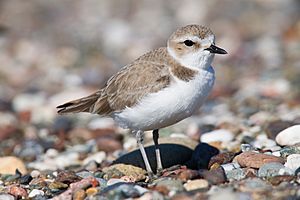Moss Landing Wildlife Area facts for kids
The Moss Landing Wildlife Area is a special place in California. It's a state wildlife preserve located right on the edge of Elkhorn Slough. This area helps protect important natural habitats and the amazing animals that live there.
Contents
What is the Moss Landing Wildlife Area?
This wildlife area protects about 728 acres of land in Monterey County, California. It's just north of the small town of Moss Landing, California. A big part of this area is one of the largest natural salt marshes on the California coast.
You can explore the reserve by walking on its trails. It's important to remember that all the plants and animals here are protected. This means you should not disturb them. It's a super popular spot for birdwatching and for seeing cute sea otters!
Rules for Visiting
While most of the area is for wildlife viewing, some limited hunting is allowed during certain times of the year. However, you cannot use rifles or pistols. The California Department of Fish and Game manages this special place.
Where is it Located?
One easy-to-reach part of the reserve is just east of Highway 1. This highway is also called the Cabrillo Highway. This section is right across from the Moss Landing Yacht Harbor.
Other parts of the reserve are north of Elkhorn Slough. Some sections are also west of the slough after it turns north. To get to the northern shore, you can find a trail entrance off Highway 1. This trail, called the Marsh Trail, is flat and leads to a small picnic area. It then goes to the main channel of Elkhorn Slough.
Nearby Natural Areas
The eastern side of Elkhorn Slough is also protected. It's part of the Elkhorn Slough National Estuarine Research Reserve. If you want to visit the beach, Moss Landing State Beach and Zmudowski State Beach are nearby. They offer access to Monterey Bay right next to the wildlife area.
A Look Back: How the Wildlife Area Started
Long ago, in the late 1800s, about 200 acres of this area were salt evaporation ponds. These ponds were used to make sea salt for local fish canneries. The company that owned them, Moss Landing Salt Works, stopped using the ponds in 1974.
The state of California officially created the wildlife area in 1984. Later, in 1992, it started working with the Monterey Bay National Marine Sanctuary to manage the area.
Helping Shorebirds Thrive
The old salt ponds are now a great home for many kinds of shorebirds. One special bird is the western snowy plover. These small birds nest in the ponds during spring. Since 1995, a group called Point Reyes Bird Observatory Conservation Science has actively worked to help them.
In 1999, experts said these ponds were the most important breeding spot for plovers in the Monterey Bay area. In 2006, the way water flowed into the ponds was improved. This was funded by groups like Ducks Unlimited and the National Fish and Wildlife Foundation.
In late fall, water levels are raised to help brown pelicans rest there. In early spring (March or April), the ponds are drained. Before the mud dries, volunteers gather for a "mudstomp." They create shallow dips in the mud, which are perfect nesting spots for the plovers.
What Birds Can You See?
It's best to bring Binoculars, telescopes, or cameras with zoom lenses. This is because you can't get too close to the birds. You can often spot Herons, sandpipers, egrets, and other waterbirds depending on the season. Sometimes, the northern entrance and trails might be closed to the public.



